
ABOVE: The west side of the Mahabodhi Temple, Bodhgaya, Bihar, India. The Bodhi tree is on the east side and not visible in this photograph.
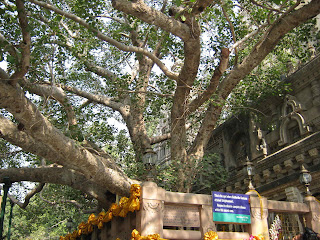
ABOVE: The north side of the Bodhi tree on the eastern side of the Mahabodhi Temple, Bodhgaya, Bihar, India.
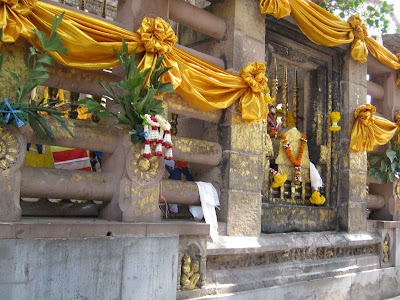
ABOVE: The railing on the east side of the Bodhi tree at the Mahabodhi Temple, Bodhgaya, Bihar, India. The Bodhi tree is behind this railing.
151 LESSON 28 01 2011 Sakka pañha Sutta Sakkas Questions FREE ONLINE eNālandā Research and Practice UNIVERSITY to VOTE for BSP ELEPHANT for Social Transformation and Economic Emancipation to attain Ultimate Bliss
through
http://www.orgsites.com/oh/awakenedone/
Awakeness Practices
All 84,000 Khandas As Found in the Pali Suttas
|
Traditionally the are 84,000 Dharma Doors - 84,000 ways to get Awakeness. Maybe so; certainly the Buddha taught a large number of practices that lead to Awakeness. This web page attempts to catalogue those found in the Pali Suttas (DN, MN, SN, AN, Ud & Sn 1). There are 3 sections: |
The discourses of Buddha are divided into 84,000, as to separate addresses. The division includes all that was spoken by Buddha.”I received from Buddha,” said Ananda, “82,000 Khandas, and from the priests 2000; these are 84,000 Khandas maintained by me.” They are divided into 275,250, as to the stanzas of the original text, and into 361,550, as to the stanzas of the commentary. All the discourses including both those of Buddha and those of the commentator, are divided into 2,547 banawaras, containing 737,000 stanzas, and 29,368,000 separate letters.
Course Programs:
LESSON 151

DN 21
PTS: D ii 276
chapter 2
Sakka-pañha Sutta: Sakka’s Questions
(excerpt)
translated from the Pali by
Thanissaro Bhikkhu
…
Having been given leave by the Blessed One, Sakka the deva-king asked him his first question: “Fettered with what, dear sir — though they think, ‘May we live free from hostility, free from violence, free from rivalry, free from ill will, free from those who are hostile’ — do devas, human beings, asuras, nagas, gandhabbas, & whatever other many kinds of beings there are, nevertheless live in hostility, violence, rivalry, ill will, with those who are hostile?”
Thus Sakka asked his first question of the Blessed One, and the Blessed One, when asked, replied: “Devas, human beings, asuras, nagas, gandhabbas, & whatever other many kinds of beings there are, are fettered with envy & stinginess, which is why — even though they think, ‘May we live free from hostility, free from violence, free from rivalry, free from ill will, free from those who are hostile’ — they nevertheless live in hostility, violence, rivalry, ill will, with those who are hostile.”
Thus the Blessed One answered, having been asked by Sakka the deva-king. Gratified, Sakka was delighted in & expressed his approval of the Blessed One’s words: “So it is, O Blessed One. So it is, O One Well-gone. Hearing the Blessed One’s answer to my question, my doubt is now cut off, my perplexity is overcome.”
Then Sakka, having delighted in & expressed his approval of the Blessed One’s words, asked him a further question: “But what, dear sir, is the cause of envy & stinginess, what is their origination, what gives them birth, what is their source? When what exists do they come into being? When what doesn’t exist do they not?”
“Envy & stinginess have dear-&-not-dear as their cause, have dear-&-not-dear as their origination, have dear-&-not-dear as what gives them birth, have dear-&-not-dear as their source. When dear-&-not-dear exist, they come into being. When dear-&-not-dear are not, they don’t.”
“But what, dear sir, is the cause of dear-&-not-dear, what is their origination, what gives them birth, what is their source? When what exists do they come into being? When what doesn’t exist do they not?”
“Dear-&-not-dear have desire as their cause, have desire as their origination, have desire as what gives them birth, have desire as their source. When desire exists, they come into being. When desire is not, they don’t.”
“But what, dear sir, is the cause of desire, what is its origination, what gives it birth, what is its source? When what exists does it come into being? When what doesn’t exist does it not?”
“Desire has thinking as its cause, has thinking as its origination, has thinking as what gives it birth, has thinking as its source. When thinking exists, desire comes into being. When thinking is not, it doesn’t.”
“But what, dear sir, is the cause of thinking, what is its origination, what gives it birth, what is its source? When what exists does it come into being? When what doesn’t exist does it not?”
“Thinking has the perceptions & categories of objectification[1] as its cause, has the perceptions & categories of objectification as its origination, has the perceptions & categories of objectification as what gives it birth, has the perceptions & categories of objectification as its source. When the perceptions & categories of objectification exist, thinking comes into being. When the perceptions & categories of objectification are not, it doesn’t.”
“And how has he practiced, dear sir: the monk who has practiced the practice leading to the right cessation of the perceptions & categories of objectification?”
“Joy is of two sorts, I tell you, deva-king: to be pursued & not to be pursued.[2] Grief is of two sorts: to be pursued & not to be pursued. Equanimity is of two sorts: to be pursued & not to be pursued.
“‘Joy is of two sorts, I tell you, deva-king: to be pursued & not to be pursued.’ Thus was it said. And in reference to what was it said? When one knows of a feeling of joy, ‘As I pursue this joy, unskillful mental qualities increase, and skillful mental qualities decline,’ that sort of joy is not to be pursued. When one knows of a feeling of joy, ‘As I pursue this joy, unskillful mental qualities decline, and skillful mental qualities increase,’ that sort of joy is to be pursued. And this sort of joy may be accompanied by directed thought & evaluation or free of directed thought & evaluation. Of the two, the latter is the more refined. ‘Joy is of two sorts, I tell you, deva-king: to be pursued & not to be pursued.’ Thus was it said. And in reference to this was it said.
“‘Grief is of two sorts, I tell you: to be pursued & not to be pursued.’ Thus was it said. And in reference to what was it said? When one knows of a feeling of grief, ‘As I pursue this grief, unskillful mental qualities increase, and skillful mental qualities decline,’ that sort of grief is not to be pursued. When one knows of a feeling of grief, ‘As I pursue this grief, unskillful mental qualities decline, and skillful mental qualities increase,’ that sort of grief is to be pursued. And this sort of grief may be accompanied by directed thought & evaluation or free of directed thought & evaluation. Of the two, the latter is the more refined. ‘Grief is of two sorts, I tell you: to be pursued & not to be pursued.’ Thus was it said. And in reference to this was it said.
“‘Equanimity is of two sorts, I tell you: to be pursued & not to be pursued.’ Thus was it said. And in reference to what was it said? When one knows of a feeling of equanimity, ‘As I pursue this equanimity, unskillful mental qualities increase, and skillful mental qualities decline,’ that sort of equanimity is not to be pursued. When one knows of a feeling of equanimity, ‘As I pursue this equanimity, unskillful mental qualities decline, and skillful mental qualities increase,’ that sort of equanimity is to be pursued. And this sort of equanimity may be accompanied by directed thought & evaluation or free of directed thought & evaluation. Of the two, the latter is the more refined. ‘Equanimity is of two sorts, I tell you: to be pursued & not to be pursued.’ Thus was it said. And in reference to this was it said.
“This is how he has practiced, deva-king: the monk who has practiced the practice leading to the right cessation of the perceptions & categories of objectification.”
Thus the Blessed One answered, having been asked by Sakka the deva-king. Gratified, Sakka was delighted in & expressed his approval of the Blessed One’s words: “So it is, O Blessed One. So it is, O One Well-gone. Hearing the Blessed One’s answer to my question, my doubt is now cut off, my perplexity is overcome.”
Then Sakka, having delighted in & expressed his approval of the Blessed One’s words, asked him a further question: “But how has he practiced, dear sir: the monk who has practiced for restraint in the Patimokkha?”
“Bodily conduct is of two sorts, I tell you, deva-king: to be pursued & not to be pursued. Verbal conduct is of two sorts: to be pursued & not to be pursued. Searching is of two sorts: to be pursued & not to be pursued.
“‘Bodily conduct is of two sorts, I tell you, deva-king: to be pursued & not to be pursued.’ Thus was it said. And in reference to what was it said? When one knows of bodily conduct, ‘As I pursue this bodily conduct, unskillful mental qualities increase, and skillful mental qualities decline,’ that sort of bodily conduct is not to be pursued. When one knows of bodily conduct, ‘As I pursue this bodily conduct, unskillful mental qualities decline, and skillful mental qualities increase,’ that sort of bodily conduct is to be pursued. ‘Bodily conduct is of two sorts, I tell you, deva-king: to be pursued & not to be pursued.’ Thus was it said. And in reference to this was it said.
“‘Verbal conduct is of two sorts, I tell you, deva-king: to be pursued & not to be pursued.’ Thus was it said. And in reference to what was it said? When one knows of verbal conduct, ‘As I pursue this verbal conduct, unskillful mental qualities increase, and skillful mental qualities decline,’ that sort of verbal conduct is not to be pursued. When one knows of verbal conduct, ‘As I pursue this verbal conduct, unskillful mental qualities decline, and skillful mental qualities increase,’ that sort of verbal conduct is to be pursued. ‘Verbal conduct is of two sorts, I tell you, deva-king: to be pursued & not to be pursued.’ Thus was it said. And in reference to this was it said.
“‘Searching is of two sorts, I tell you, deva-king: to be pursued & not to be pursued.’ Thus was it said. And in reference to what was it said? When one knows of a search, ‘As I pursue this search, unskillful mental qualities increase, and skillful mental qualities decline,’ that sort of search is not to be pursued. When one knows of a search, ‘As I pursue this search, unskillful mental qualities decline, and skillful mental qualities increase,’ that sort of search is to be pursued. ‘Searching is of two sorts, I tell you, deva-king: to be pursued & not to be pursued.’ Thus was it said. And in reference to this was it said.
“This is how he has practiced, deva-king: the monk who has practiced the practice for restraint in the Patimokkha.”
Thus the Blessed One answered, having been asked by Sakka the deva-king. Gratified, Sakka was delighted in & expressed his approval of the Blessed One’s words: “So it is, O Blessed One. So it is, O One Well-gone. Hearing the Blessed One’s answer to my question, my doubt is now cut off, my perplexity is overcome.”
Then Sakka, having delighted in & expressed his approval of the Blessed One’s words, asked him a further question: “But how has he practiced, dear sir: the monk who has practiced for restraint with regard to the sense faculties?”
“Forms cognizable by the eye are of two sorts, I tell you, deva-king: to be pursued & not to be pursued. Sounds cognizable by the ear… Aromas cognizable by the nose… Flavors cognizable by the tongue… Tactile sensations cognizable by the body… Ideas cognizable by the intellect are of two sorts: to be pursued & not to be pursued.”
When this was said, Sakka the deva-king said to the Blessed One, “Dear sir, I understand the detailed meaning of the Blessed One’s brief statement. If, as one pursues a certain type of form cognizable by the eye, unskillful mental qualities increase, and skillful mental qualities decline, that sort of form cognizable by the eye is not to be pursued. But if, as one pursues a certain type of form cognizable by the eye, unskillful mental qualities decline, and skillful mental qualities increase, that sort of form cognizable by the eye is to be pursued.
“If, as one pursues a certain type of sound cognizable by the ear…
“If, as one pursues a certain type of aroma cognizable by the nose…
“If, as one pursues a certain type of flavor cognizable by the tongue…
“If, as one pursues a certain type of tactile sensation cognizable by the body…
“If, as one pursues a certain type of idea cognizable by the intellect, unskillful mental qualities increase, and skillful mental qualities decline, that sort of idea cognizable by the intellect is not to be pursued. But if, as one pursues a certain type of idea cognizable by the intellect, unskillful mental qualities decline, and skillful mental qualities increase, that sort of idea cognizable by the intellect is to be pursued.
“This is how I understand the detailed meaning of the Blessed One’s brief statement. Hearing the Blessed One’s answer to my question, my doubt is now cut off, my perplexity is overcome.”
Then Sakka, having delighted in & expressed his approval of the Blessed One’s words, asked him a further question: “Dear sir, do all priests & contemplatives teach the same doctrine, adhere to the same precepts, desire the same thing, aim at the same goal?”
“No, deva-king, not all priests & contemplatives teach the same doctrine, adhere to the same precepts, desire the same thing, aim at the same goal.”
“Why, dear sir, don’t all priests & contemplatives teach the same doctrine, adhere to the same precepts, desire the same thing, aim at the same goal?”
“The world is made up of many properties, various properties. Because of the many & various properties in the world, then whichever property living beings get fixated on, they become entrenched & latch onto it, saying, ‘Only this is true; anything else is worthless.’ This is why not all priests & contemplatives teach the same doctrine, adhere to the same precepts, desire the same thing, aim at the same goal.”
“But, dear sir, are all priests & contemplatives utterly complete, utterly free from bonds, followers of the utterly holy life, utterly consummate?”
“No, deva-king, not all priests & contemplatives are utterly complete, utterly free from bonds, followers of the utterly holy life, utterly consummate.”
“But why, dear sir, are not all priests & contemplatives utterly complete, utterly free from bonds, followers of the utterly holy life, utterly consummate?”
“Those monks who are released through the total ending of craving are the ones who are utterly complete, utterly free from bonds, followers of the utterly holy life, utterly consummate. This is why not all priests & contemplatives are utterly complete, utterly free from bonds, followers of the utterly holy life, utterly consummate.”
Thus the Blessed One answered, having been asked by Sakka the deva-king. Gratified, Sakka was delighted in & expressed his approval of the Blessed One’s words: “So it is, O Blessed One. So it is, O One Well-gone. Hearing the Blessed One’s answer to my question, my doubt is now cut off, my perplexity is overcome.”
Then Sakka, having delighted in & expressed his approval of the Blessed One’s words, said to him: “Yearning is a disease, yearning is a boil, yearning is an arrow. It seduces one, drawing one into this or that state of being, which is why one is reborn in high states & low. Whereas other outside priests & contemplatives gave me no chance to ask them these questions, the Blessed One has answered at length, so that he has removed the arrow of my uncertainty & perplexity.”
“Deva-king, do you recall having asked other priests & contemplatives these questions?”
“Yes, lord, I recall having asked other priests & contemplatives these questions.”
“If it’s no inconvenience, could you tell me how they answered?”
“It’s no inconvenience when sitting with the Blessed One or one who is like him.”
“Then tell me, deva-king.”
“Having gone to those whom I considered to be priests & contemplatives living in isolated dwellings in the wilderness, I asked them these questions. But when asked by me, they were at a loss. Being at a loss, they asked me in return, ‘What is your name?’
“Being asked, I responded, ‘I, dear sir, am Sakka, the deva-king.’
“So they questioned me further, ‘But what kamma did you do to attain to this state?’
“So I taught them the Dhamma as far as I had heard & mastered it. And they were gratified with just this much: ‘We have seen Sakka, the deva-king, and he has answered our questions!’ So, instead of my becoming their disciple, they simply became mine. But I, lord, am the Blessed One’s disciple, a stream-winner, steadfast, never again destined for states of woe, headed for self-awakening.”
“Deva-king, do you recall ever having previously experienced such happiness & joy?”
“Yes, lord, I do.”
“And how do you recall ever having previously experienced such happiness & joy?”
“Once, lord, the devas & asuras were arrayed in battle. And in that battle the devas won, while the asuras lost. Having won the battle, as the victor in the battle, this thought occurred to me: ‘Whatever has been the divine nourishment of the asuras, whatever has been the divine nourishment of the devas, the devas will now enjoy both of them.’ But my attainment of happiness & joy was in the sphere of violence & weapons. It didn’t lead to disenchantment, to dispassion, to cessation, to calm, to direct knowledge to self-awakening, to Unbinding. But my attainment of happiness & joy on hearing the Blessed One’s Dhamma is in the sphere of no violence, the sphere of no weapons. It leads to disenchantment, to dispassion, to cessation, to calm, to direct knowledge to self-awakening, to Unbinding.”
…
Then Sakka, the deva-king, touched the earth with his hand and said three times, “Homage to the Worthy One, the Blessed One, the Rightly Self-awakened One! Homage to the Worthy One, the Blessed One, the Rightly Self-awakened One! Homage to the Worthy One, the Blessed One, the Rightly Self-awakened One!”
While this explanation was being given, there arose to Sakka the dustless, stainless Dhamma eye — “Whatever is subject to origination is all subject to cessation” — as it also did to [his following of] 80,000 other devas.
Such were the questions that the Blessed One answered at Sakka’s bidding. And so this discourse is called “Sakka’s Questions.”
Note
1.
Objectification = papañca. The tendency of the mind to proliferate issues from the sense of “self.” This term can also be translated as self-reflexive thinking, reification, falsification, distortion, elaboration, or exaggeration. In the discourses, it is frequently used in analyses of the psychology of conflict. The categories of objectification stem from the self-reflexive thought, “I am the thinker,” (see Sn 4.14), and include the categories of inappropriate attention (see MN 2): being/not-being, me/not-me, mine/not-mine, doer/done-to. The perceptions of objectification include such thoughts as “This is me. This is mine. This is my self.” These perceptions and categories turn back on the person who allows them to proliferate, giving rise to internal conflict & strife, which then expand outward. For more on these terms, see MN 18.
2.
For further discussion of the skillful and unskillful pursuit of these feelings, see MN 101 and MN 137.
http://www.accesstoinsight.org/tipitaka/dn/dn.21.2x.than.html
BUDDHA (EDUCATE)! DHAMMA (MEDITATE)! SANGHA (ORGANISE)!
WISDOM IS POWER
Awakened One Shows the Path to Attain Eternal Bliss
Using such an instrument
The Free ONLINE e-Nālandā Research and Practice University has been re-organized to function through the following Schools of Learning :
Buddha’s Sangha Practiced His Dhamma Free of cost, hence the Free- e-Nālandā Research and Practice University follows suit
As the Original Nālandā University did not offer any Degree, so also the Free e-Nālandā Research and Practice University.
The teachings of Buddha are eternal, but even then Buddha did not proclaim them to be infallible. The religion of Buddha has the capacity to change according to times, a quality which no other religion can claim to have…Now what is the basis of Buddhism? If you study carefully, you will see that Buddhism is based on reason. There is an element of flexibility inherent in it, which is not found in any other religion.
Bhimrao Ramji Ambedkar , Indian scholar, philosopher and architect of Constitution of India, in his writing and speeches
IKAMMA,REBIRTH,AWAKEN-NESS,BUDDHA,THUS COME ONE,DHAMMA II.ARHA ,FOUR HOLY TRUTHS,EIGHTFOLD PATH,TWELVEFOLD CONDITIONED ARISING,BODHISATTVA,PARAMITA,SIX PARAMITAS III.SIX SPIRITUAL POWERS,SIX PATHS OF REBIRTH,TEN DHARMA REALMS,FIVE SKANDHAS,EIGHTEEN REALMS,FIVE MORAL PRECEPTS IV. MEDITATION,MINDFULNESS,FOUR APPLICATIONS OF MINDFULNESS,LOTUS POSTURE,SAMADHI,CHAN SCHOOL,FOUR JHANAS,FOUR FORMLESS REALMS V. FIVE TYPES OF BUDDHIST STUDY AND PRACTICE,MAHAYANA AND HINAYANA COMPARED,PURE LAND,BUDDHA RECITATION,EIGHT CONSCIOUSNESSES,ONE HUNDRED DHARMAS,EMPTINESS VI. DEMON,LINEAGE
with
Level I: Introduction to Buddhism,Level II: Buddhist Studies,
TO ATTAIN
Level III: Stream-Enterer,Level IV: Once – Returner,Level V: Non-Returner,Level VI: Arhat
Jambudvipa, i.e, PraBuddha Bharath scientific thought in
mathematics,astronomy,alchemy,andanatomy
Philosophy and Comparative Religions;Historical Studies;International Relations and Peace Studies;Business Management in relation to Public Policy and Development Studies;Languages and Literature;and Ecology and Environmental Studies
Jambudvipa, i.e, PraBuddha Bharath scientific thought in
Mathematics
Astronomy
Alchemy
And
Anatomy
Dhamma Experience
http://kalyaano.blogspot.com/2009/12/india-kolkata-bodhgaya-gaya-rajgir.html
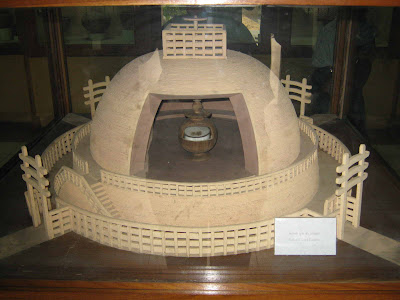
ABOVE: Display of Lord Buddha’s relics in the Minor Antiquities Annex at the India Museum, Kolkata. The relics are visible and contained in a small pottery container. The surrounding structure appears to be a scale model of an ancient stupa that may have existed at the time of Asoka.

ABOVE: Stone box at the India Museum, Kolkata that once contained Lord Buddha’s relics
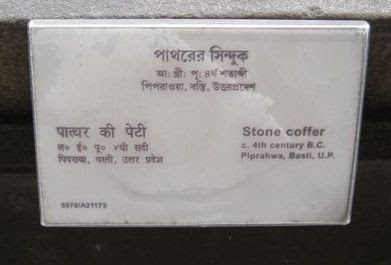
ABOVE: The inadequate official label on the stone box at the India Museum, Kolkata that once contained Lord Buddha’s relics

ABOVE: Deep Guest House, Bodh Gaya, Bihar State, India, December 2009

ABOVE: The path leading up to Dungeshwara Cave. You can see the some of the beggars waiting for pilgrims and the temple at the site of the cave (white colour building in the centre of the photo).
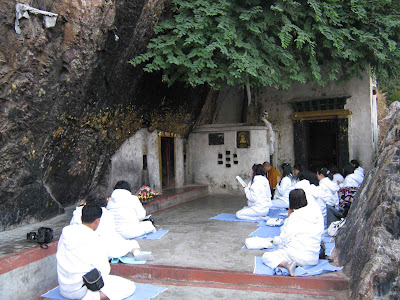
ABOVE: The veranda outside the Dungeshwara Cave. I was told the cave itself is the rectangular opening on the left in between the two groups of Thai chanter pilgrims.

ABOVE: The Indasala Cave, 7km east of Rajgir (Raajagaha). The cave is the dark spot in the centre of the photo. The other dark spot on the left centre is a crack in the rock and not a cave.
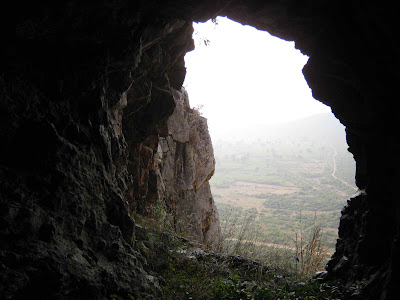
ABOVE: Looking out from the entrance to Indasala Cave.

ABOVE: A view looking south west from Indasala Cave.
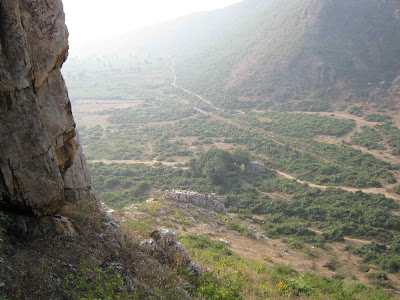
ABOVE: A view looking south east from Indasala Cave. The car and a small neglected Hindu temple is behind the clump of trees in the lower centre of the photo.

ABOVE: A view looking south at Venavana, Rajgir, Bihar, India.

ABOVE: A view looking east at Sattapana Cave, Rajgir, Bihar, India.
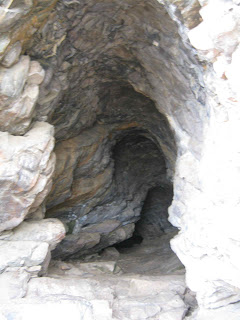
ABOVE: The entrance to one of the caves at the Sattapana Cave site, Rajgir, Bihar, India. Note
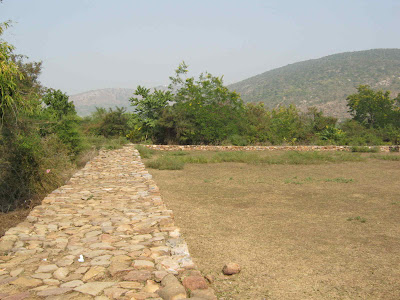
ABOVE: The supposed site of King Bimbisaara’s Goal, Rajgir, Bihar, India.
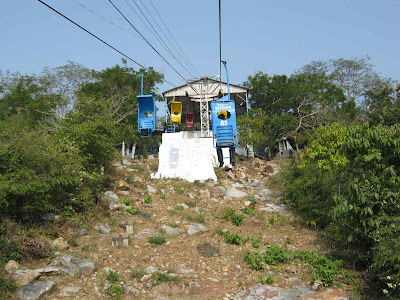
ABOVE: The chair lift going up to the Japanese Stupa and Gijjhakuta, Rajgir, Bihar, India.
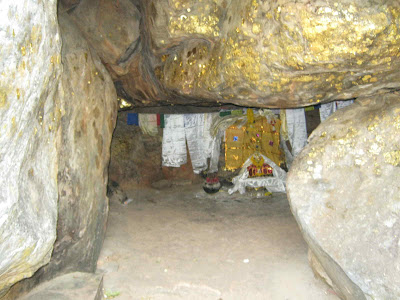
ABOVE: One of the caves alleged to be the Boar’s Grotto, Gijjhakuta, Rajgir, Bihar, India
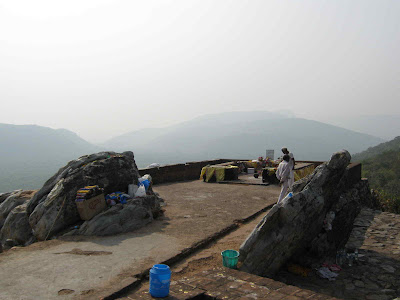
ABOVE: One of the plat forms at Gijjhakuta, Rajgir, Bihar, India. This location has the remains of several kutis used by ascetics in the past 2500 years. This location in the photo had the most ribbons, gold film, scarves, candles and incense etc. That doesn’t necessarily mean it was the precise location of Lord Buddha’s kuti. The local men were there to sell water, incense and other paraphernalia.